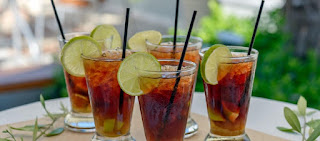It hardly seems possible that we are almost half way through the
year. The onset of summer will herald those typically British activities,
Chelsea Flower Show, horse racing at Ascot, Henley Regatta. Glyndebourne, and
of course Wimbledon, none of which would be complete without the cry of ‘Anyone
for Pimm’s?’ ringing in our ears.
Pimm's
is also the standard cocktail at polo matches as well as being a very
popular choice for garden parties.
First
produced in 1823 by James Pimm, a farmer’s son from Kent who became the owner
of an oyster bar in the City of London. To aid the digestion of his customers
he began to offer a gin based tonic containing a secret mixture of herbs and
liqueurs. It was served in a small tankardknown as a No. 1 Cup, hence its
name.
Such
was the demand that large scale production began in 1851 and the distillery
began selling it commercially in 1859, at thirty shillings a bottle, with
hawkers peddling it, literally, on bicycles.
Pimm
eventually sold on the business, and the right use his name to Frederick Sawyer
in 1880, with the future Lord Mayor of London, Horatio Davies, taking it over in 1887, and
franchising the Oyster Houses.
Pimm’s
has a dark brown colour with a reddish hue, and tastes both citrusy and spicy.
Traditionally
served as a long summer drink, topped up with fizzy lemonade and a garnish of
cucumber and borage added; although nowadays pubs often throw the whole fruit
bowl into the mix, with a sprig of mint to top it off.
Ginger
ale is commonly used a substitute for the lemonade.
Given
my penchant for bubbly, I am rather partial to a ‘Pimm’s Royal Cup’.
Personally, I think it would be sacrilegious to use Champagne; am inclined to use Prosecco or Cava
instead.
1½
oz Pimm's No.
1
Sparkling wine
Sparkling wine
Lemon peel
Cucumber peel
Cucumber peel
Simply
pour the Pimm's over ice in a tall glass. Top up with champagne, garnish with
lemon and cucumber peel.
Pimm’s
can also be used to make a lovely refreshing jelly for a posh summer dessert,
and when frozen, alcoholic ice lollies.
Ideal
for picnics, pre-mixed Pimm’s can be bought in 250ml. cans at 5.4%abv, for
around £1.90, when compared with the original Pimm’s No. 1 strength of 25%abv.,
at £15 for a 1 litre bottle.
In
addition to the ever popular No 1 cup, with its gin base, the range has been
extended to include six others, based on a variety of alcoholic bases, most of
which have since been withdrawn from sale.
Other
attempts to retain its place in the drinks market include the introduction of Pimm's Winter Cup, based on No.3,
with a brandy base, and which is generally mixed with warm apple juice, No. 6,
which has a vodka base, and also a Blackberry & Elderflower Pimm’s.
I
have sampled them all but still think the original takes a lot of beating.
In
2015 The American Bar at the
Savoy hotel in London launched a vintage Pimm’s menu to coincide with the first
day of Wimbledon, using rare 1940s bottles. A mere snip at £45 per cocktail.
I
was interested while carrying out research on the history of Pimm’s, to find
out a bit more about tankards.
Around
the time that Pimm’s was invented metal tankards with glass bottoms were
popular. One legend has it that it was developed as a way of refusing the
King’s Shilling, conscription into the British army or navy. The glass bottom
enabled the drinker to see whether or not a shilling had been placed in the
tankard, and the drink could be refused, thereby avoiding conscription.
Another
story is that a bar fight would be started when the first punch was thrown
while the recipient had the tankard raised to his mouth; the glass bottom was
implemented so that he could see the attack coming.
Finally,
on April Fool’s Day in 2016 Pimm’s fooled us all, even managing to get BBC’s
Peter Sissons on board, with their spoof announcement of their sponsorship of
Big Ben’s restoration, including plans to update the dial of Elizabeth Tower.








No comments:
Post a Comment